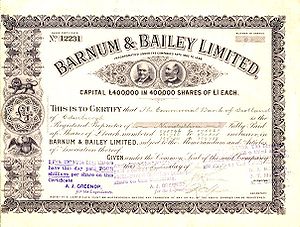Effective pieces
In the banking sector, physically available, i.e. actually printed, securities are called effective pieces (also known as panels ) .
General
The technical term “effective pieces” relates to effects , but is not derived from it. Rather, it concerns effectively (actually and physically) existing securities in contrast to value rights within the framework of collective safe custody , which are only still available in the books and therefore cannot be delivered. Issuers nowadays rarely offer effective shares for reasons of cost. Former nonvaleurs today enjoy high collector values among collectors .
construction
An effective piece usually consists of a coat and bow.
coat
The coat evidences the claim or membership right.
arc
The arch certifies the right to income . It consists of coupons (coupons) and a coupon .
Coupons
The coupons (profit share certificates) entitle the holder to receive dividends or interest . They are submitted to a custody account centrally; In the case of self-custody , you have to cut the coupon called up and submit it to a bank. In the case of self-custody, changes such as share splitting or capital increases must also be observed. With the latter, a coupon is called for exercising subscription rights .
Talon
The talon (renewal coupon) is used to obtain a new sheet if all coupons should be used up.
species
In securities law , a distinction is made between the following forms of securitization :
- Effective pieces consist of the coat and the sheet, which contains a maximum of 20 coupons. Printing is subject to strict printing guidelines from the stock exchanges .
- Global certificates are issued for issues with a short term or maturity , such as German bonds. Technical global certificates allow effective pieces at the request of an investor. The more frequent permanent global certificates , however, exclude effective pieces.
- Debt register entries in the Federal debt register include a securitization in physical form according to § 6 , para. 3 Federal debt management law (BSchWG) from.
layout
Securities that are traded on stock exchanges must be printed in A4 format. For ordinary shares and investment units , the jacket must be printed in landscape format , for preference shares , participation certificates or bonds in portrait format ; Sheets are always printed in portrait orientation.
Consignment
When delivering effective items from self- custody by customers, credit institutions must take particular care :
- Coat and bow must be complete and belong together (matching piece number of coat and bow)
- the securities must really be
- the securities have available be
- the securities must not show any damage
- The securities may not be in a so-called opposition list (Part IV of the Journal of Economic and Banking Law to be listed), so neither lost gone, stolen been or otherwise has lost his
The reason for this strictness is § 367 HGB , according to which banks even with bearer securities not in good faith property can be purchased from stolen, lost or otherwise mislaid bearer securities if at the time of sale or pledging the loss of the paper in the Federal Gazette disseminated and since the end of the year, in which the publication was made, no more than one year had passed.
In addition, in order to avoid money laundering , according to Section 10 (3) of the Natural Gas Act , credit institutions are obliged to verify the consignor's identity from a market value of more than EUR 15,000 .
meaning
Effective pieces are hardly of any significance on the market today because the shares and bonds are securitized in global certificates. However, effective pieces are still printed as jewelry and souvenirs that have the same rights as globally notarized stocks.
In addition, effective pieces are collected as historical securities .
Individual evidence
- ↑ Reinhold Adrian, Thomas Heidorn (ed.): The bank operation . 2000, p. 262.
- ↑ Reinhold Adrian, Thomas Heidorn (ed.): The bank operation . 2000, p. 263.
- ↑ Deutsche Börse of April 17, 2000: Common principles of the German stock exchanges for the printing of securities . Retrieved November 29, 2019.
- ↑ German Institute for Internal Auditing e. V. - Working group revision of the securities business (Ed.): Examination of the securities service business . 2005, p. 127 f.
